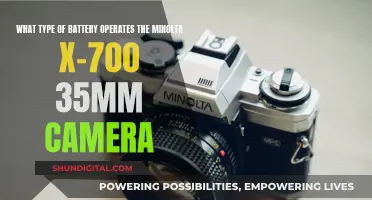
Panasonic's Post Focus function is a feature available on some Lumix cameras that allows photographers to select a point of focus after a shot is taken. The feature is designed to work with the camera's existing Depth from Defocus autofocusing and movie capabilities. When the feature is switched on, every shot will be recorded using this mode. The camera's autofocusing system scans the lens around the subject, moving from the foreground to the background to cover the entire scene. This results in a movie clip containing about 30 frames, from which the photographer can then select the desired frame to save.
| Characteristics | Values |
|---|---|
| What is Post Focus? | A function on Lumix cameras that allows photographers to select a point of focus after a shot is taken and provide the ability to select different points of focus within the same image. |
| How does it work? | Post Focus works with the camera's existing Depth from Defocus autofocusing and movie capabilities. The 4K movie recording function is used to record roughly one second of MP4 video at 30 frames/second. During this recording, the camera's autofocusing system scans the lens around the subject, moving from the foreground to the background to cover the entire scene. |
| How to use it? | After the image has been captured, review it on the camera's screen and select the frames containing the desired sharp area. When a frame is selected, the camera will ask if you wish to save the frame. |
| Limitations | Post Focus works best with static scenes. It is not suitable for capturing moving subjects or panning the camera during the exposure. |
| Compatible Lumix cameras | DMC-GX8, DMC-G7 and DMC-FZ300 |
What You'll Learn
- Post Focus allows photographers to select a point of focus after a shot is taken
- The feature is designed to work with the camera's existing Depth from Defocus autofocusing and movie capabilities
- Post Focus is available on the DMC-GX8, DMC-G7 and DMC-FZ300
- The system is simpler than the pan-focusing systems developed by Lytro
- Post Focus works best with wide lens apertures

Post Focus allows photographers to select a point of focus after a shot is taken
Post Focus is a feature available on Panasonic Lumix cameras that allows photographers to select a point of focus after a shot is taken. It is designed to be used with scenes that are primarily static, and works by recording a burst of images focused on different points, which can then be selected by the photographer. The feature is accessed through the camera's shooting menu, and when activated, every shot will be recorded using this mode.
The Post Focus function works in conjunction with the camera's 4K video capabilities. When a photo is taken, the camera records a small movie clip in 4K at 30 frames per second, with the autofocusing system scanning the lens around the subject and moving from the foreground to the background. This results in a movie clip containing about 30 frames, each with a different focus point. The photographer can then review the clip on the camera's screen and select the frames with the desired sharp area. These selected frames can then be saved as individual JPEG files.
One of the advantages of Post Focus is that it provides a rich source of material for focus stacking, which can increase the depth of field in a scene. It also allows for different perspectives to be pulled from an image, depending on the part that is in focus. Additionally, it can be useful for macro photography, as it enables focus stacking without the need for a tripod.
However, there are also some limitations to the Post Focus feature. The final image is limited to 8 megapixels, and the process can be too slow for capturing fast-moving subjects. It is also not suitable for scenes with a lot of movement, as the camera needs to be looking at the same content during the pre-exposure scan and when recording.
Logitech Webcams: Where Are They Manufactured?
You may want to see also

The feature is designed to work with the camera's existing Depth from Defocus autofocusing and movie capabilities
The Post Focus feature on Lumix cameras is an innovative approach to focus bracketing. It works with the camera's existing Depth from Defocus (DFD) autofocusing and movie capabilities. When the feature is enabled, the camera records a small movie clip in 4K at 30 frames per second. During this recording, the camera's autofocusing system scans the lens around the subject, moving from the foreground to the background to cover the entire scene. This results in a movie clip containing about 30 frames, each with a different focus point.
The benefit of using the Panasonic system is that multiple images can be collected in a very short space of time, and a tripod is usually not needed. The images are automatically collected, and the user only needs to review the clip to extract the desired frames. The user can specify various settings in Post Focus mode, including aperture, ISO, filter effects, picture modes, exposure modes, and aspect ratio.
The Post Focus feature is designed to be used with primarily static scenes. It may not work well with moving subjects or when panning the camera during the exposure. The camera needs to be looking at the same content during the recording as it did during the pre-exposure scan. However, it can work with moving subjects if they remain within the frame during the exposure.
The main advantage of the Panasonic system over competitors like Lytro is that it is included in regular cameras, and the images are larger, easier to view, and more readily usable. Light field cameras, such as Lytro, offer benefits beyond Post Focus, such as reducing depth-of-field, directly selecting depth-of-field via a virtual aperture control, and depth-based image editing.
Moonlite Focuser: Capturing the Moon's Rotation
You may want to see also

Post Focus is available on the DMC-GX8, DMC-G7 and DMC-FZ300
The Post Focus function is an innovative approach to focus stacking, achieved by integrating two existing functions in Panasonic's latest cameras. It is much simpler and cleverer than the pan-focusing systems developed by Lytro and Light. It also utilises functions already available in the latest cameras without compromising any of the camera’s capabilities or performance.
To use the Post Focus feature, photographers need to update the firmware of their camera to version 2.0. This can be done for free at the LUMIX Global Customer Support Site. Once the firmware is installed, a Post Focus mode setting will be added to the camera’s shooting menu. Photographers can then switch on the Post Focus mode, and every shot will be recorded using this mode.
The Post Focus feature is particularly useful for focus stacking, especially in macro photography. It allows photographers to capture images with a shallow depth of field and a sharp focus on the desired subject, without the need for additional equipment or complex setup. It also provides a rich source of material for a focus stack, effectively increasing the depth of field in a given scene at a given aperture setting.
While the Post Focus function is a clever innovation, there are some limitations to its use. The feature is designed for scenes that are primarily static, as it requires the camera to be looking at the same content during the pre-exposure scan and the recording. Additionally, the final image will have a maximum resolution of 8 megapixels, which may not be sufficient for certain types of photography or large prints.
Tennessee Camera Tickets: What Happens if You Don't Pay?
You may want to see also

The system is simpler than the pan-focusing systems developed by Lytro
The Post Focus function on Lumix cameras allows photographers to select a point of focus after an image is taken, providing the ability to select different points of focus within the same image. This is achieved by integrating two existing functions in the latest Lumix cameras: the camera's Depth from Defocus (DFD) autofocusing and movie capabilities.
The Post Focus system works by recording a one-second MP4 video at 30 frames per second. During this recording, the camera's autofocusing system scans the lens, moving from the foreground to the background to cover the entire scene. This results in a movie clip containing about 30 frames, with the AF system searching for and identifying focus points. After capturing the image, you can review it on the camera's screen, select the desired frames, and save them as separate JPEG files.
This approach is much simpler than the pan-focusing systems developed by Lytro, which was a pioneer in light-field cameras. Lytro cameras capture information about the light field emanating from a scene, including the intensity of light and the precise direction of light rays. They use an array of micro-lenses placed in front of an image sensor to sense intensity, colour, and directional information. While Lytro cameras offered innovative features, the Panasonic Post Focus system is more straightforward and does not compromise the camera's capabilities or performance.
Fight Camera Tickets: A Guide for Los Angeles Drivers
You may want to see also

Post Focus works best with wide lens apertures
The Post Focus function on Lumix cameras allows photographers to select a point of focus after an image is taken. This is achieved by integrating the camera's Depth from Defocus autofocusing and movie capabilities. The 4K movie recording function records a short video at 30 frames per second, during which the autofocusing system scans the lens around the subject, covering the entire scene. This results in a sequence of frames with different points of focus, which can be reviewed and selected for saving as individual JPEG files.
While the Post Focus function is beneficial in various situations, it is essential to understand that it works best with wide lens apertures. When using the P mode, the camera typically selects the fastest lens aperture, ensuring optimal results with Post Focus. However, using Post Focus in other shooting modes might not yield the desired outcome if the lens aperture is significantly reduced.
The advantage of using wide lens apertures with Post Focus is that it provides more opportunities for focus stacking, allowing photographers to increase the depth of field. This is particularly useful in situations where it is challenging to stop down the aperture. Additionally, wide apertures help mitigate diffraction-related issues, preventing the loss of sharpness at small apertures.
It is worth noting that while Post Focus excels with wide apertures, it does not compromise the camera's capabilities or performance. Photographers can still utilise the camera's full potential while taking advantage of the ability to adjust the point of focus after capturing an image. This feature offers creative freedom and flexibility, enabling photographers to explore different perspectives and focus options within the same image.
In conclusion, Post Focus on Lumix cameras is most effective when used with wide lens apertures. By setting the camera to P mode, photographers can ensure they capture images with the fastest lens aperture, making it easier to select the desired point of focus during post-processing. This unique feature enhances the photographic experience, providing users with more control and creative possibilities.
Eufy Camera Battery Life: Replace or Recharge?
You may want to see also
Frequently asked questions
Post Focus is a function on Lumix cameras that allows photographers to select a point of focus after a shot is taken.
Post Focus works by recording a burst of images in 4K resolution at 30fps, detecting up to 49 areas of a frame to set focus at different points.
Post Focus allows for greater creative freedom in photography, enabling photographers to pull different perspectives out of an image and choose the best shot that meets their intention.
Post Focus is designed for use with static scenes and may not work well with moving subjects or panning the camera during the exposure. The final image is also limited to 8MP.







